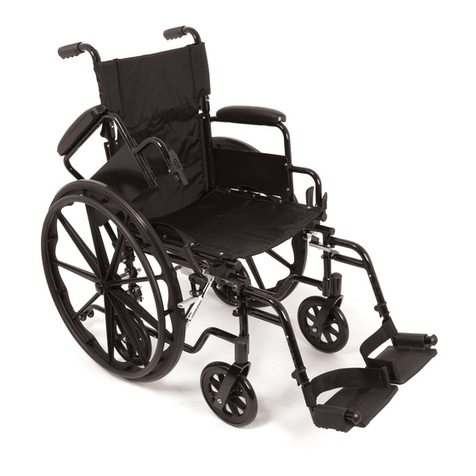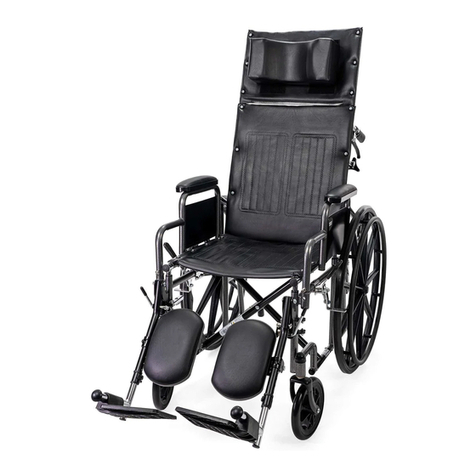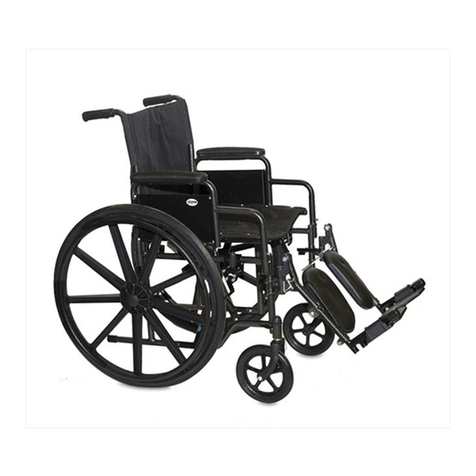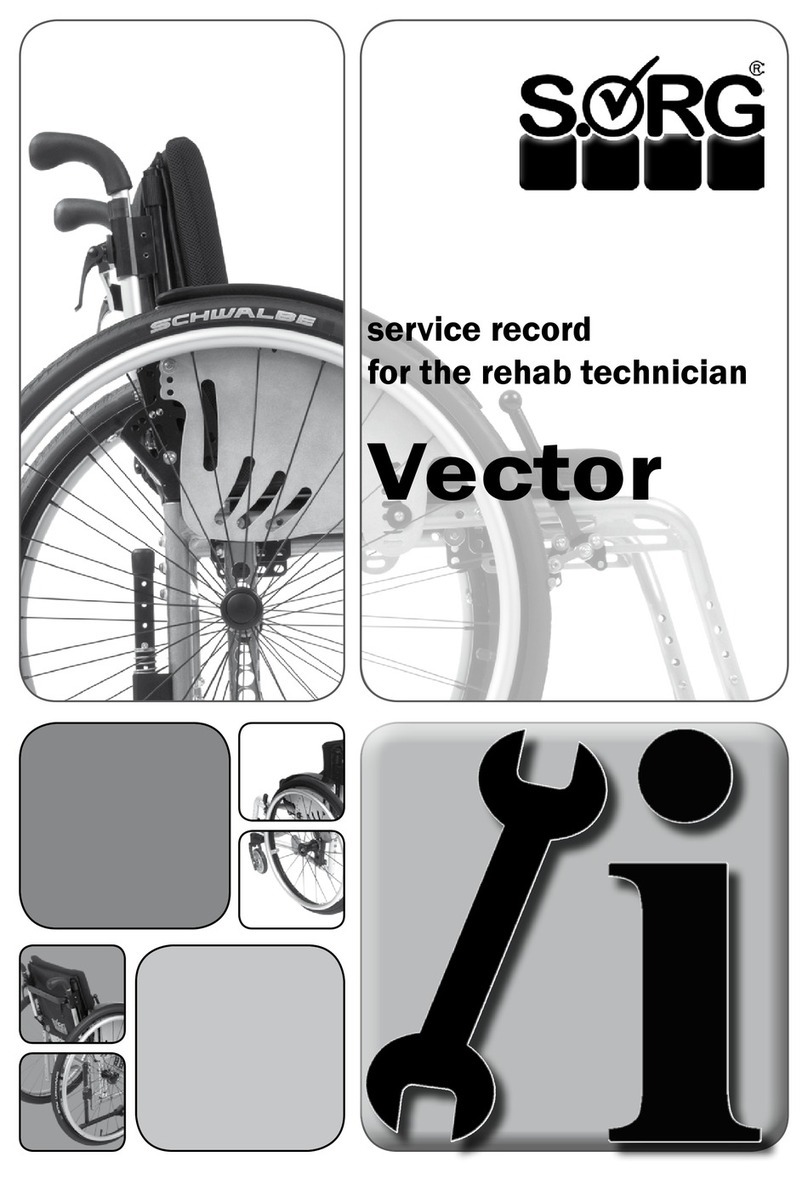Probasics 9200 User manual

TRANSPORT CHAIRS
OPERATORS MANUAL
MODEL NO. 9200--------17” BURGUNDY PROBASICS LIGHTWEIGHT ALUMINUM
TRANSPORT CHAIR
MODEL NO. 9200GR-------17” GREEN PROBASICS LIGHTWEIGHT ALUMINUM
TRANSPORT CHAIR
MODEL NO. 9200BL --------17” BLUE PROBASICS LIGHTWEIGHT ALUMINUM
TRANSPORT CHAIR
MODEL NO. 9200BK--------17” BLACK PROBASICS LIGHTWEIGHT ALUMINUM
TRANSPORT CHAIR
MODEL NO. 9201------19” BURGUNDY PROBASICS LIGHTWEIGHT ALUMINUM
TRANSPORT CHAIR
MODEL NO. 9201BL-----19” BLUE PROBASICS LIGHTWEIGHT ALUMINUM
TRANSPORT CHAIR
MODEL NO. 9201GR-----19”GREEN PROBASICS LIGHTWEIGHT ALUMINUM
TRANSPORT CHAIR
MODEL NO. 9201S------19” SILVER PROBASICS LIGHTWEIGHT ALUMINUM
TRANSPORT CHAIR
MODEL NO. 9201BK------19” BLACK PROBASICS LIGHTWEIGHT ALUMINUM
TRANSPORT CHAIR
MODEL NO. 9300BK-----21” BLACK PROBASICS LIGHTWEIGHT ALUMINUM
TRANSPORT CHAIR
MODEL NO. 9300----21” BURGUNDY PROBASICS LIGHTWEIGHT ALUMINUM
TRANSPORT CHAIR
MODEL NO. 9600GRVP----19” GREY PLAID UPHOLSTERY PROBASICS
LIGHTWEIGHT ALUMINUM TRANSPORT CHAIR
MODEL NO. 9600GRNP----19” GREEN PLAIN UPHOLSTERY PROBASICS
LIGHTWEIGHT ALUMINUM TRANSPORT CHAIR
MODEL NO. 9400----BURGUNDY 19” LIGHTWEIGHT ALUMINUM TRANSPORT
CHAIR W/REAR CABLE HAND BRAKES
MODEL NO. 9400BK---BLACK 19” LIGHTWEIGHT ALUMINUM TRANSPORT CHAIR
W/REAR CABLE HAND BRAKES

1
MODEL NO. 9500---BURGUNDY 22”HEAVY DUTY TRANSPORT CHAIR
MODEL NO. 9500BK---BLACK 22”HEAVY DUTY TRANSPORT CHAIR
MODEL NO. 9015---TRANSPORT CHAIR W/ 19” SEAT WIDTH
MODEL NO. 0005---TRANSPORT CHAIR W/ 17” SEAT WIDTH
PROBASICS LIGHTWEIGHT 19”LIGHTWEIGHT ALUMINUM
ALUMINUM TRANSPORT CHAIR TRANSPORT CHAIR W/REAR CABLE
22”HEAVY DUTY TRANSPORT TRANSPORT CHAIR W/19”
CHAIR (BARIATRIC) SEAT WIDTH
NOTE: Check ALL parts for shipping damage before use. In case of shipping damage,
DO NOT use. Contact Carrier/Dealer for further instruction.

2
Index
1. General Guidelines................................................................................ 4
2. Operating Information............................................................................ 6
3. Weight Training ..................................................................................... 8
4. Weight Limitations ................................................................................... 8
5. Safety/Handling of Wheelchairs ............................................................ 8
6. Stability and Balance............................................................................. 9
7. Coping w/Everyday Obstacles ............................................................ 10
8. A Note to Wheelchair Assistants......................................................... 10
9. Percentage of Weight Distribution....................................................... 11
10. Reaching, Leaning and Bending Forward........................................... 11
11. Reaching, Leaning Backwards............................................................ 12
12. Tipping................................................................................................. 12
13. Stairways ............................................................................................. 13
14. Folding and Unfolding Wheelchair ...................................................... 14
15. Safety Inspection................................................................................. 15
16. Safety Inspection Checklist ................................................................. 15
17. Inspect/Adjust Initially.......................................................................... 15
18. Inspect/Adjust Weekly ......................................................................... 16
19. Inspect/Adjust Monthly ........................................................................ 16
20. Inspect/Adjust Periodically .................................................................. 17
21. Maintenance ........................................................................................ 17
22. Suggested Maintenance Procedures .................................................. 18
23. Front Rigging ....................................................................................... 18
24. Installing Swingaway Footrest Assembly ............................................ 19
25. Adjusting Footplate Height .................................................................. 19
26. Back...................................................................................................... 20

3
27. Unfolding/Folding the Fold-down Back ............................................... 20
28. Replacing Back Upholstery ................................................................. 21
29. Replacing Seat Upholstery.................................................................. 22
30. Rear Wheels........................................................................................ 22
31. Removing/Installing Rear Wheels ....................................................... 22
32. Casters ................................................................................................ 23
33. Replacing Adjusting Front Folks.......................................................... 23
34. Replacing Front Caster ........................................................................ 24
35. Hand Brakes/Wheel Locks .................................................................. 24
36. Locking/Unlocking/Using Hand Brakes ............................................... 24
37. Adjusting Cable Adjuster Unit.............................................................. 25
38. Adjusting Wheel Lock.......................................................................... 26
39. Limited Lifetime Warranty.................................................................... 26

4
GENERAL GUIDLINES
Brakes
must be
locked
before
using seat

5
No Transport Chair has been approved for use as a
seating surface inside a motor vehicle. This label is
for informational purposes only. Liability issues
were not considered in the attachment of this label
The wheel locks on this transport chair have
been preset at the factory to comply with the
Veterans Administration functional Standards.

6
OPERATING INFORMATION
To determine and establish your particular safety limits, practice bending, reaching and
transferring activities in several combinations in the presence of a qualified health
professional BEFORE attempting active use of the wheelchair.
Make sure the back is locked securely BEFORE using this wheelchair.
ALWAYS verify that the hand grips on the rear cane are secure prior to use when an
assistant is used to propel the chair.
DO NOT attempt to reach objects if you have to move forward in the seat.

7
DO NOT attempt to reach objects if you have to pick them up from the floor by reaching
down between your knees.
DO NOT lean over the top of the back upholstery. This will change your center of gravity
and may cause you to tip over.
DO NOT shift your weight or sitting position toward the direction you are reaching as the
wheelchair may tip over.
DO NOT tilt the wheelchair without assistance.
DO NOT use an escalator to move a wheelchair between floors. Serious bodily injury
may
occur.
DO NOT leave the Bariatric Transport on inclined surfaces. The wheel locks and hand
brakes may not hold the Bariatric Transport on inclined surfaces due to the wheelchair’s
increased weight capacity.
Wheel locks are NOT brakes. DO NOT attempt to stop a moving wheelchair with the
wheel locks.
Before attempting to transfer in or out of the wheelchair, every precaution should be
taken to reduce the gap distance. Turn both casters parallel to the object you are
transferring onto. When transferring to and from the wheelchair, ALWAYS ENGAGE
BOTH WHEEL LOCKS. If the wheelchair is equipped with hand brakes, ALWAYS LOCK
BOTH HAND BRAKES before transferring to and from the wheelchair.
DO NOT sit or transfer into the wheelchair unless it is fully open.
DO NOT operate on roads, streets or highways.
DO NOT climb, go up or down ramps or traverse slopes greater than 9 degrees.
DO NOT attempt to move up or down an incline with a water, ice or oil film.
DO NOT attempt to ride over curbs or obstacles. Doing so may cause your wheelchair to
tip over and cause bodily harm or damage to the wheelchair.
Probasics products are specifically designed and manufactured for use in conjunction
with
Probasics accessories. Accessories designed by other manufacturers have not been
tested by Probasics and are not recommended for use with Probasics products.
DO NOT over tighten hardware attaching to the frame. This could cause damage to the
frame tubing.

8
Keep hands and fingers clear of moving parts to avoid injury.
DO NOT use the footplate as a platform when getting in or out of the wheelchair.
ALWAYS wear your seat-positioning strap. Inasmuch as the seat positioning strap is an
option on the Probasics Transport and the Lightweight Transport (you can order these
wheelchairs with or without the seat positioning strap), Probasics strongly recommends
ordering the seat-positioning strap as an additional safeguard.
The seat-positioning strap is a positioning belt only. It is not designed for use as a safety
device withstanding high stress loads such as auto or aircraft safety belts. If signs of
wear
appear, the belt MUST be replaced immediately.
DO NOT attempt to lift the wheelchair by any removable (detachable) parts. Lifting by
means of any removable (detachable) parts of a wheelchair may result in injury to the
user
or damage to the wheelchair.
DO NOT stand on the frame of the wheelchair.
WEIGHT TRAINING
Probasics DOES NOT recommend the use of its wheelchairs as a weight training
apparatus. Probasics wheelchairs have NOT been designed or tested as a seat for any
kind of weight training. If occupant uses said wheelchair as a weight training apparatus,
PROBASICS SHALL NOT BE LIABLE FOR BODILY INJURY AND THE WARRANTY
WILL BE VOID.
WEIGHT LIMITATIONS
The following are the weight limitations for the Invacare transports:
TRANSPORT WEIGHT LIMITATION (LBS)
Transport ----------------------250 lbs
Lightweight Transport ------250 lbs
Bariatric Transport ---------- 400 lbs
Lite Transport ----------------250 lbs
SAFETY/HANDLING OF WHEELCHAIRS
Safety and handling of the wheelchair requires the close attention of the wheelchair user
as well as the assistant. This manual points out the most common procedures and

9
techniques involved in the safe operation and maintenance of the wheelchair. It is
important to practice and master these safe techniques until you are comfortable in
maneuvering around the frequently encountered architectural barriers.
Use this information only as a basic guide. The techniques that are discussed on the
following pages have been used successfully by many.
Individual wheelchair users often develop skills to deal with daily living activities that
may differ from those described in this manual. Probasics recognizes and encourages
each individual to try what works best for him/her in overcoming architectural obstacles
that they may encounter. However, all warnings and cautions given in this manual
MUST be followed. Techniques in this manual are a starting point for the new
wheelchair user and assistant with safety as the most important consideration for all.
Stability and Balance
WARNING
ALWAYS wear your seat-positioning strap. Inasmuch as the seat-positioning strap
is an option on the Probasics Transport (you can order this wheelchair with or
without the seat positioning strap), Probasics strongly recommends ordering the
seat-positioning strap as an additional safeguard.
The seat-positioning strap is a positioning belt only. It is not designed for use as a
safety device withstanding high stress loads such as auto or aircraft safety belts.
If signs of wear appear, the belt must be replaced immediately.
To assure stability and proper operation of your wheelchair, you must at all times
maintain proper balance. Your wheelchair has been designed to remain upright and
stable during normal daily activities as long as you do not move beyond the center of
gravity.
Virtually all activities which involve movement in the wheelchair have an effect on the
center of gravity. Probasics recommends using seat/chest positioning straps for
additional
safety while involved in activities that shift your weight.
DO NOT lean forward out of the wheelchair any further than the length of the armrests.
Make sure the casters are pointing in the forward position whenever you lean forward.
This can be achieved by advancing the wheelchair and then reversing it in a straight
line.

10
Coping With Everyday Obstacles
Coping with the irritation of everyday obstacles can be alleviated somewhat by learning
how to manage your wheelchair. Keep in mind your center of gravity to maintain stability
and balance.
A Note to Wheelchair Assistants
When assistance to the wheelchair user is required, remember to use good body
mechanics. Keep your back straight and bend your knees whenever tipping the
wheelchair or traversing curbs, or other impediments.
WARNING
DO NOT attempt to lift the wheelchair by any removable (detachable) parts.
Lifting by means of any removable (detachable) parts of a wheelchair may result
in
injury to the user or damage to the wheelchair.
Always verify that hand grips on the rear cane are secure PRIOR to use when an
assistant is used to propel or lift the chair. Check for any signs of looseness or
deterioration and if found, contact a qualified technician. DO NOT attempt to move
the wheelchair by pulling on the handgrips if they are found to be unsecure or
have deteriorated.
Also, be aware of detachable parts such as armrests or leg rests. These must NEVER
be

11
used to move the wheelchair or as lifting supports, as they may be inadvertently
released,
resulting in possible injury to the user and/or assistant(s).
When learning a new assistance technique, have an experienced assistant help you
before attempting it alone.
Percentage of Weight Distribution
WARNING
Many activities require the wheelchair owner to reach, bend and transfer in and
out of the wheelchair. These movements will cause a change to the normal
balance, the center of gravity, and the weight distribution of the wheelchair. To
determine and establish your particular safety limits, practice bending, reaching
and transferring activities in several combinations in the presence of a qualified
healthcare professional BEFORE attempting active use of the wheelchair.
Proper positioning is essential for your safety. When reaching, leaning, or bending
forward, it is important to use the front casters as a tool to maintain stability and balance.
Reaching, Leaning and Bending Forward
Position the front casters so that they are extended as far forward as possible and
lock the hand brakes.
WARNING
DO NOT attempt to reach objects if you have to move forward in the seat or
pick them up from the floor by reaching down between your knees.

12
Reaching, Leaning Backwards
WARNING
DO NOT lean over the top of the back upholstery. This will change your center
of gravity and may cause you to tip over.
Position wheelchair as close as possible to the desired object. Point front casters
forward to create the longest possible wheelbase. Reach back only as far as your
arm will extend without changing your sitting position.
Tipping
WARNING
DO NOT tip the wheelchair without assistance.
When tipping the wheelchair, an assistant should grasp the back of the wheelchair on a
non-removable (non-detachable) part. Inform the wheelchair occupant before tipping the

13
wheelchair and remind him/her to lean back. Be sure the occupant’s feet and hands are
clear of all wheels and/or pinch points.
After mastering the techniques of tipping the wheelchair, use the following method to
tackle curbs, short stairs, etc.
Place a foot on the step tube and begin to tilt the wheelchair toward you. Apply a
continuous downward motion until the balance point is achieved and the front casters
clear the curb. At this point, the assistant will feel a difference in the weight distribution
WARNING
When lowering the front casters of the wheelchair, DO NOT let the wheelchair
drop the last few inches to the ground. This could result in injury to the occupant
and/or damage to the wheelchair.
Roll the wheelchair forward and slowly lower the front of the wheelchair in one
continuous movement onto the sidewalk. Push the wheelchair forward until the rear
wheels roll up and over the curb.
Stairways
WARNING
ALWAYS wear your seat-positioning strap. Inasmuch as the seat-positioning strap
is an option on the Probasics Transport and the Lightweight Transport (you can
order these wheelchairs with or without the seat positioning strap), Probasics
strongly recommends ordering the seat-positioning strap as an additional
safeguard.
The seat-positioning strap is a positioning belt only. It is not designed for use as a
safety device withstanding high stress loads such as auto or aircraft safety belts.
If
signs of wear appear, the belt must be replaced immediately.
DO NOT attempt to lift a wheelchair by lifting on any removable (detachable)
parts. Lifting by means of any removable (detachable) parts of a wheelchair may
result in injury to the user or damage to the wheelchair.
Always verify that hand grips on the rear cane are secure prior to use when an
assistant is used to propel or lift the chair. Check for any signs of looseness or
deterioration and if found, contact a qualified technician. DO NOT attempt to
move the wheelchair by pulling on the handgrips if they are found to be unsecure
or have deteriorated.

14
Extreme caution is advised when it is necessary to move an occupied wheelchair
up or down the stairs. Probasics recommends that, if possible, the user be
removed from the wheelchair prior to moving. Probasics recommends using two
(2) assistants and making thorough preparations. Make sure to use ONLY secure,
non-detachable parts for hand-held supports.
Follow this procedure for moving the wheelchair between floors when an elevator is
NOT
available:
1. After the wheelchair has been tilted back to the balance point, one assistant (in the
rear) backs the wheelchair up against the first step, while securely grasping a
non-removable (non-detachable) part of the wheelchair for leverage.
2. The second assistant, with a firm hold on a non-detachable part of the framework, lifts
the wheelchair up and over the stair and steadies the wheelchair as the first assistant
places one (1) foot on the next stair and repeats STEP 1.
3. The wheelchair should not be lowered until the last stair has been negotiated and the
wheelchair has been rolled away from the stairway.
WARNING
DO NOT use an escalator to move a wheelchair between floors. Serious bodily
injury may occur.
Folding and Unfolding Wheelchair
Unfolding
1. Open the wheelchair by grasping the push handle of the wheelchair closest
to you.
2. Tilt the wheelchair toward you (raising the opposite wheel and caster off the
ground/floor).
3. Push downward on the top of the seat rail closest to you where the seat upholstery is
attached until the wheelchair is fully open.
Folding
WARNING
ALWAYS use the straps on the seat rails when folding the wheelchair. Otherwise,
hands and fingers may become pinched between the seat rail and the armrest and
injury may occur.

15
1. Swing the footrest/leg rest in locked position to the front of the wheelchair.
2. Pivot the footplates upward to vertical position.
3. Grasp the two (2) straps on the seat rails and pull up to begin closing the wheelchair.
4. Continue to close the wheelchair by grasping the armrest furthest from you and
pulling the armrest toward you.
SAFETY INSPECTION
NOTE: Every six (6) months take your wheelchair to a qualified technician for a thorough
inspection and servicing. Regular cleaning will reveal loose or worn parts and enhance
the smooth operation of your wheelchair. To operate properly and safely, your
wheelchair must be cared for just like any other vehicle. Routine maintenance will
extend the life and efficiency of your wheelchair.
Safety Inspection Checklists
Initial adjustments should be made to suit your personal body structure and
preference. Thereafter follow these maintenance procedures:
Inspect/Adjust Initially
_ Ensure wheelchair rolls straight (no excessive drag or pull to one side).
_ Inspect seat and back upholstery for rips or sagging.
_ Inspect back cane handgrips for wear, looseness, and/or deterioration.
_ Inspect for any loose or broken hardware on the wheelchair.
_ Inspect the seat-positioning strap for any signs of wear. Ensure the buckle latches.
Verify that the hardware that attaches the strap to the frame is secure and undamaged.
Replace if necessary.

16
_ Ensure that there is no excessive side movement or binding when the rear wheels are
lifted and spun.
_ Inspect for cracked, broken or loose spokes.
_ Ensure the wheel/fork assembly has proper tension when the caster is spun. The
caster
should come to a gradual stop.
_ Loosen/tighten the locknut if the wheel wobbles noticeably or binds to a stop.
_ Ensure the wheel bearings are clean and free of moisture.
CAUTION
As with any vehicle, wheels and tires should be checked periodically for cracks
and wear and should be replaced as necessary.
_ Inspect the tires for flat spots and wear.
_ Ensure the hand brakes do not interfere with the tires when rolling.
_ Ensure the hand brake pivot points are free of wear and looseness.
_ Ensure the hand brakes are easy to engage.
_ Clean upholstery and armrests.
Inspect/Adjust Weekly
_ Ensure the wheelchair rolls straight (no excessive drag or pull to one side).
_ Inspect for cracked, broken or loose spokes.
_ Ensure the wheel/fork assembly has proper tension when caster is spun. The caster
should come to a gradual stop.
_ Ensure the hand brakes do not interfere with tires when rolling.
_ Ensure the hand brake pivot points are free of wear and looseness.
Inspect/Adjust Monthly

17
_ Inspect for any loose or broken hardware on the wheelchair.
_ Inspect back cane handgrips for wear, looseness, and/or deterioration.
_ Loosen/tighten the locknut if the wheel wobbles noticeably or binds to a stop.
_ Ensure the wheel bearings are clean and free of moisture.
CAUTION
As with any vehicle, the wheels and tires should be checked periodically for
cracks
and wear and should be replaced as necessary.
_ Ensure the hand brakes do not interfere with the tires when rolling.
Inspect/Adjust Periodically
_ Ensure the wheelchair rolls straight (no excessive drag or pull to one side).
_ Inspect the seat and the back upholstery for rips or sagging.
_ Inspect the seat-positioning strap for any signs of wear. Ensure the buckle latches.
Verify that the hardware that attaches the strap to the frame is secure and undamaged.
Replace if necessary.
_ Ensure that there is no excessive side movement or binding when the rear wheels are
lifted and spun.
_ Ensure the wheel bearings are clean and free of moisture.
CAUTION
As with any vehicle, the wheels and tires should be checked periodically for
cracks
and wear and should be replaced as necessary.
_ Inspect the tires for flat spots and wear.
_ Ensure the hand brakes are easy to engage.
_ Clean the upholstery and armrests.
Maintenance
Maintenance Safety Precautions

18
WARNING
After ANY adjustments, repair or service and BEFORE use, make sure all
attaching
hardware is tightened securely. Otherwise, injury or damage can result.
CAUTION
DO NOT over tighten the hardware attaching to the frame. This could cause
damage
to the frame tubing.
Suggested Maintenance Procedures
1. Before using your wheelchair make sure all the nuts and bolts are tight. Check all the
parts for damage or wear and replace. Check all parts for proper adjustment.
2. The wheels and tires should be checked periodically for cracks and wear, and should
be replaced by a qualified technician if damaged.
3. Periodically adjust the wheel locks in correlation to tire wear. Refer to Adjusting
4. Periodically check the front caster and the rear wheel hubs to make sure they are
clean
and free of cracks.
WARNING
When cleaning the rear cane or handgrip areas, use only a clean towel lightly
dampened with cool water. Verify that grips are dry prior to use. The use of soap
or
ammonia based cleaning solutions will result in the handgrips sliding off the cane
assembly. Failure to observe this warning could result in injury to the user or
bystanders.
5. Hand grips should be checked monthly for wear/looseness. Clean if desired.
6. Check the upholstery for sagging, rips or tears.

19
FRONT RIGGINGS
WARNING
After ANY adjustments, repair or service and BEFORE use, make sure all
attaching
hardware is tightened securely. Otherwise, injury or damage may result.
Installing Swingaway Footrest Assembly
1. Turn the footrest to the side (open footplate is perpendicular to wheelchair).
2. Install the hinge plates on the footrest onto the hinge pins on the wheelchair frame.
3. Push the footrest towards the inside of the wheelchair until it locks into place.
NOTE: The footplate will be on the inside of the wheelchair when locked in place.
4. Repeat this procedure for the other footrest assembly.
5. To release the footrest, push the footrest release lever inward, rotate the footrest
outward.
This manual suits for next models
18
Table of contents
Other Probasics Wheelchair manuals
Popular Wheelchair manuals by other brands
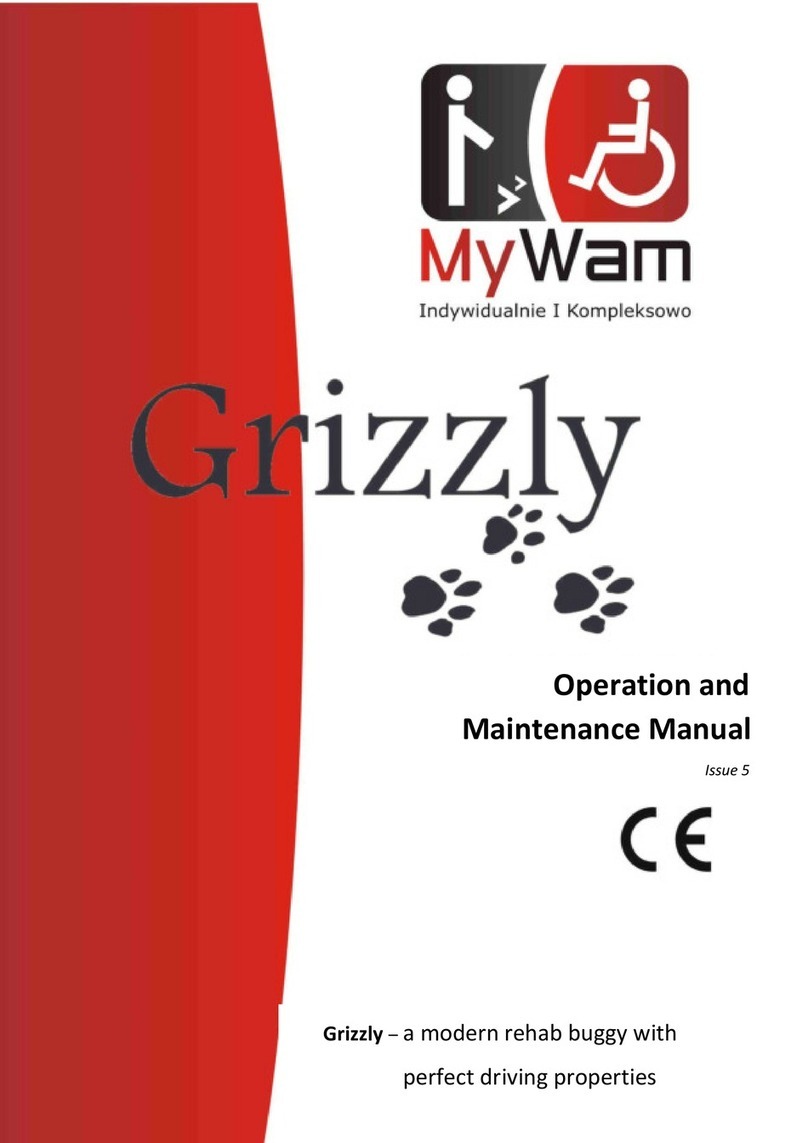
MyWam
MyWam Grizzly Operation and maintenance manual
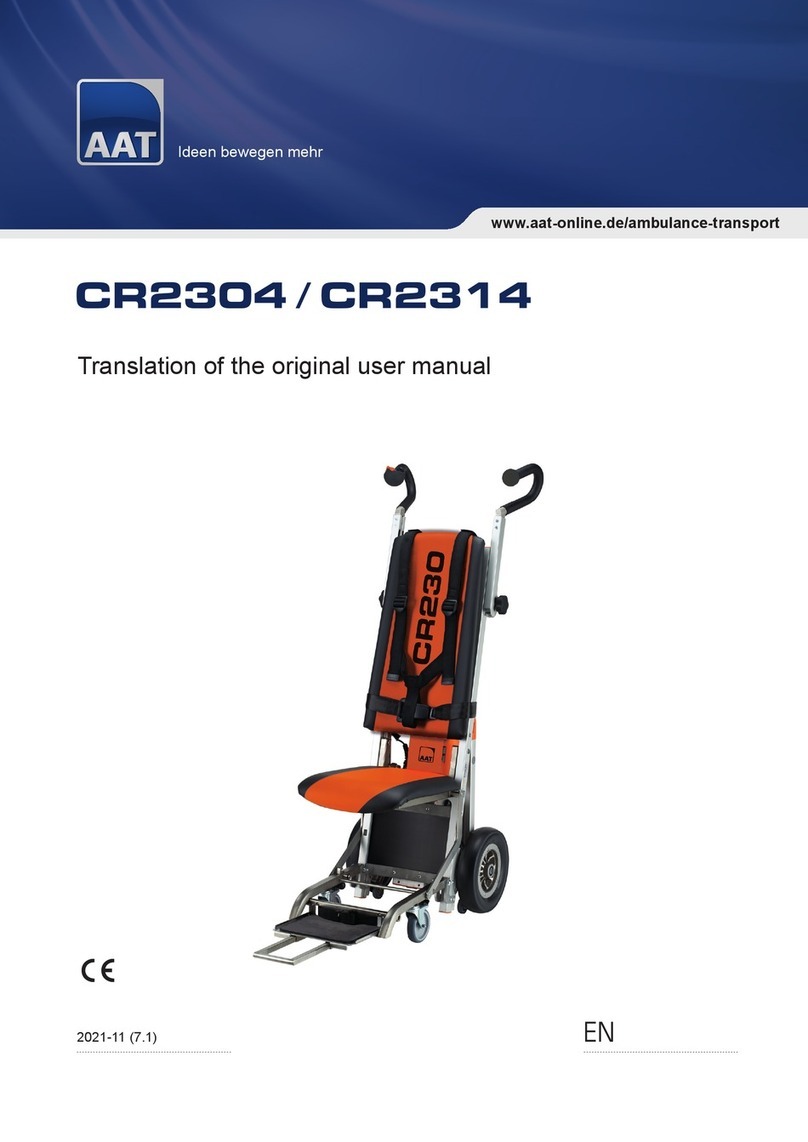
AAT
AAT CR2304 Translation of the original user manual
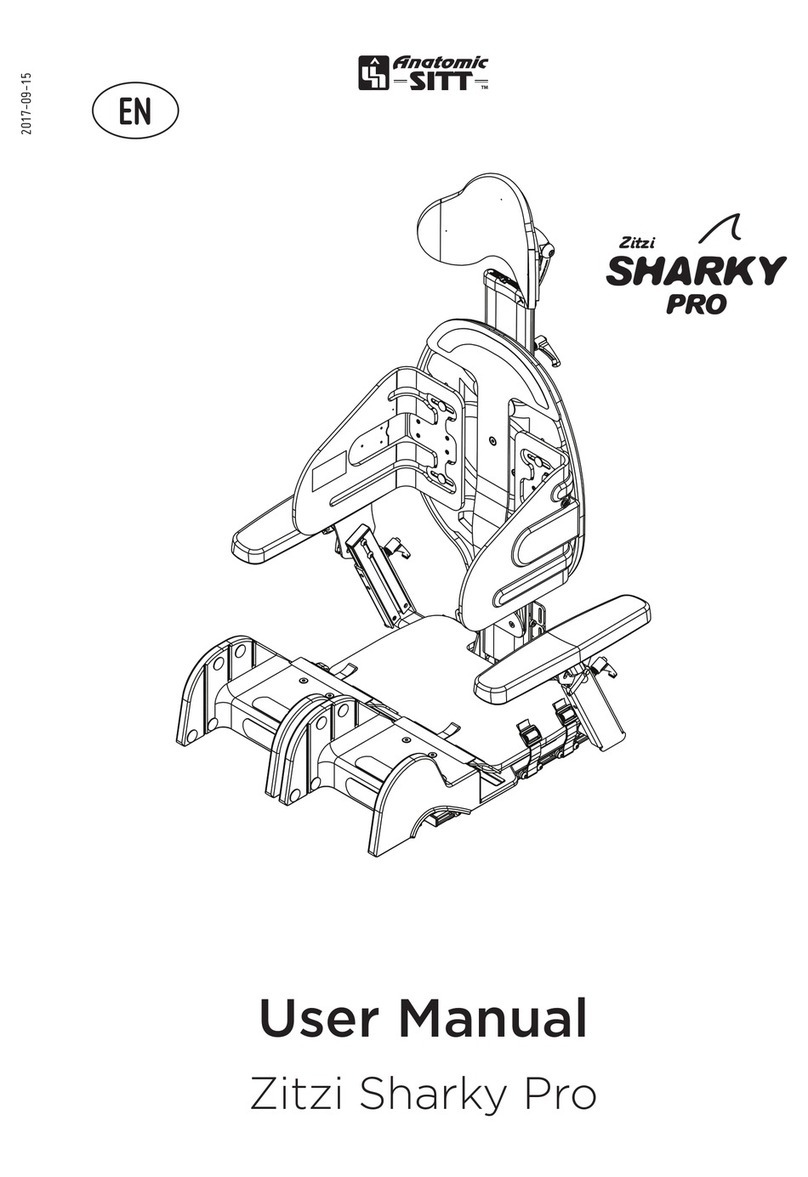
Anatomic SITT
Anatomic SITT Zitzi Sharky Pro user manual

Karman
Karman PW-F500 series owner's manual

AMG Medical
AMG Medical MedPro DEFENSE Zorbi 770-305 Assembly instructions
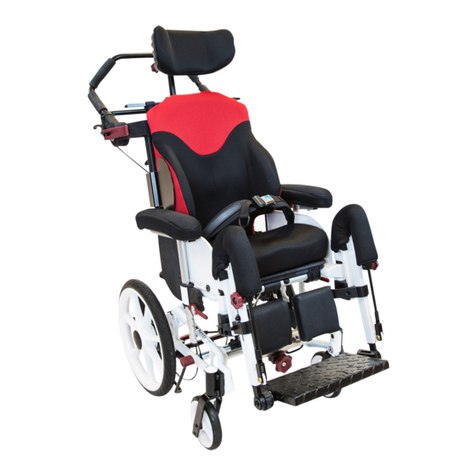
Netti
Netti DYNAMIC S user manual

Sunrise Medical
Sunrise Medical Jay Active Back User instruction manual & warranty
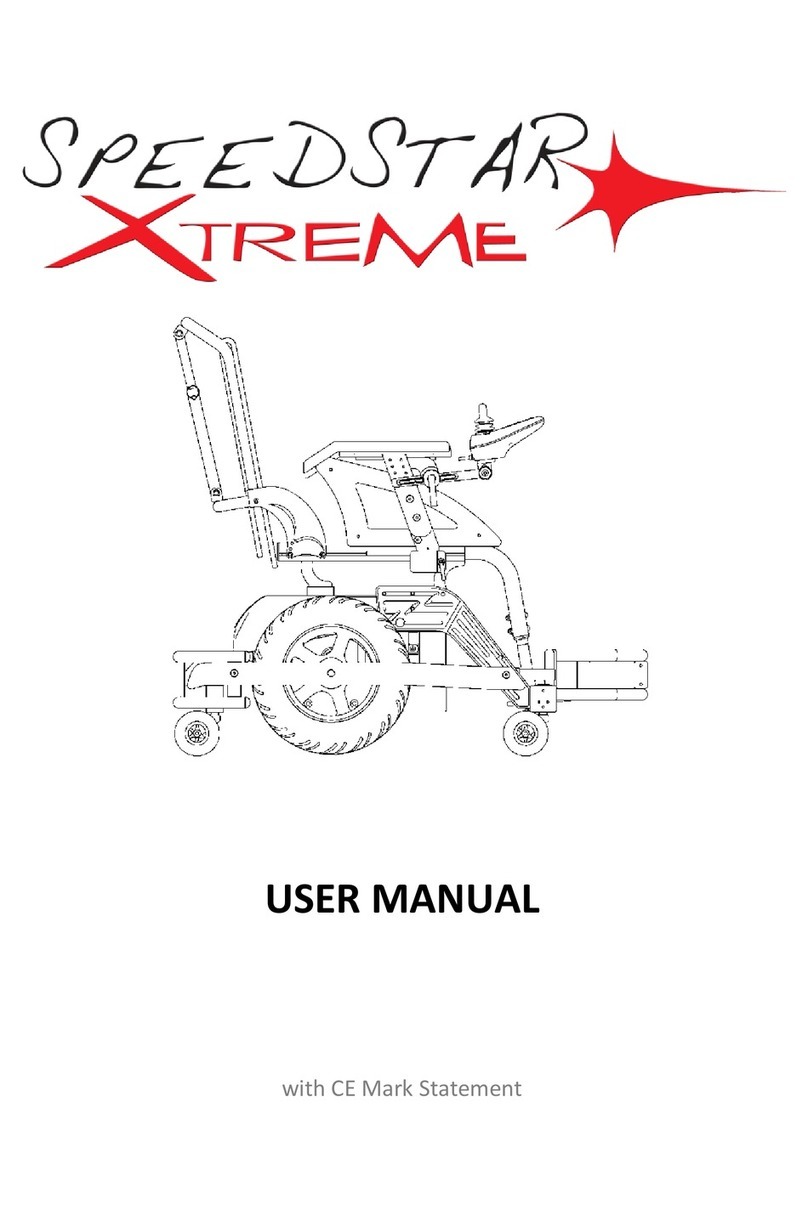
Neatech
Neatech speedstar xtreme user manual
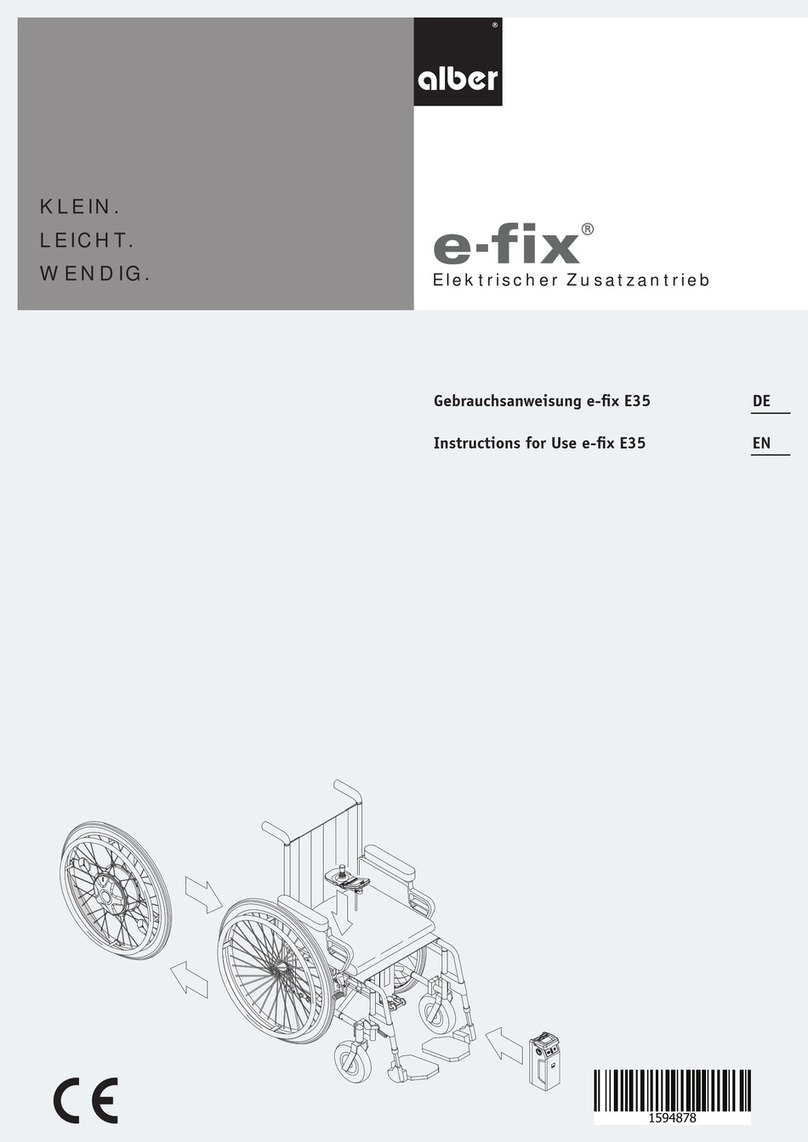
Alber
Alber e-fix E35 Instructions for use

Decon wheel
Decon wheel MED3056 Assembly instructions

Sunrise Medical
Sunrise Medical QUICKIE SOPUR Nitrum Directions for use

Sanction Industry
Sanction Industry MF-5630 instruction manual


